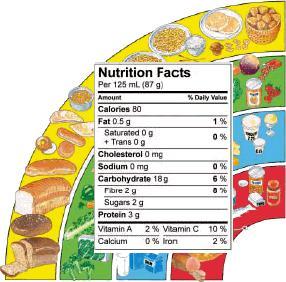
Nutrition Label Lies?
If you ever look at nutrition labels on your food, and are fairly knowledgeable about how calories are calculated, then you might have noticed that sometimes the math on the nutrition labels doesn’t add up correctly. Are food producers outright lying on their nutrition labels or do they not know simple elementary-school level math? While it’s true that the calories stated on the nutrition label of a food do not equal the actual amount of calories in the product (even when you account for serving size), most of the time the calculations on the label actually are correct.
If you aren’t familiar with how the calories on nutrition labels are calculated, here’s some background info:
In general, each gram of carbohydrate contains 4 calories, each gram of protein contains 4 calories, and each gram of fat contains 9 calories. Dietary fiber is a specific type of carbohydrate that contains 0 calories. Therefore, you can multiple the number of grams of fats by 9, the number of grams of carbohydrates by 4, and the number of proteins by 4, and then add these 3 numbers together. Then multiply the number of grams of fiber by 4, and subtract that number from your total. That should give you the number of calories that are printed on the nutrition label.
Oftentimes, the number of calories printed on the label doesn’t match your calculation of [#Fats(9) + #Carbs(4) + #Proteins(4)] – #Fiber(4).
Sometimes it’s less and sometimes it’s more. So what’s going on? Did the company miscalculate? Did they skip elementary school math class?
No. The reason the calculation doesn’t match yours is because you skipped elementary school nutrition class. Don’t feel bad though, because most people never take an actual nutrition class in their entire lives — even doctors!
Unless you’re a registered dietician, you went to an extremely good school of natural health, or you’ve self-educated yourself in nutrition, you don’t know that not all carbohydrates have 4 calories, not all dietary fiber has 0 calories, and not all fats have 9 calories.
So let’s break it down. Which carbohydrates don’t have 4 calories and how many calories do they have? Which fats don’t have 9 calories? And which dietary fibers do have calories?
In general, sugar alcohols only have 2 calories per gram. Sugar alcohols containing only 2 calories per gram include xylitol (2.4 kcal/g), sorbitol (2.6 kcal/g), mannitol (1.6 kcal/g), isomalt (2.0 kcal/g), and maltilol (2.1 kcal/g). These sugar alcohols are often used in old-school “sugar free” candies made for people with diabetes. The problem with them, though, is that they can cause uncomfortable gas and bloating because they can ferment in your intestines. Xylitol works a little differently and doesn’t ferment in your intestines, and is mostly used in oral hygiene products like toothpaste, mouthwash, and gum (at least the more expensive and better quality ones).
Xylitol has antimicrobial properties and can starve out bacteria in your mouth and nasal passages as well as candida yeast overgrowth in your intestines.
If you get your food from the “natural” section of grocery stores, or if you shop at places such as Whole Foods, Trader Joe’s, Henry’s, Wild Oats, Mother’s Market, Erewhon, Jimbo’s, or….one of the oodles of natural food stores that are popping up all over the world, you’ve noticed low calorie and zero calorie foods containing erythritol. This particular sugar alcohol is special because it only has 0.2 kcal/g and is 15 times sweeter than sucrose (table sugar) and all the other sugar alcohols. It has the least amount of calories and the most amount of sweetness. So while one teaspoon of table sugar has about 20 calories, one teaspoon of eythritol has 1 calorie and that 1 calorie of erythritol is 15 times sweeter than the 20 calories of sucrose. It doesn’t cause painful bloating and gas like most sugar alcohols, and it also appears to have some of the antimicrobial/anti-candida properties that xylitol has.
And most importantly, it’s not a poisonous neurotoxin like sucralose (Splenda), acesulfame K (Sweet One, E950), and aspartame (NutraSweet).
So this is why zero calorie beverages containing erythritol may say they contain 7 grams of carbs and 0 calories (and not the 28 calories you’d normally expect). In reality, a beverage with 7 grams of carbs from erythritol actually contains 1.4 calories, so it is listed as 0 on the nutrition label.
Now as for grams of dietary fiber, any kind of insoluble fiber has 0 calories. This is because it passes your digestive tract undigested. Insoluble fiber, however, is changed by fermentation in your digestive tract, so some calories are actually extracted. It’s estimated that most insoluble fiber renders about 2 calories per gram, similar to most sugar alcohols. You need both insoluble and soluble fiber, for good health, by the way. And the good news is that most whole plant-based foods do contain both. So if you’re eating a food that contains high-fiber plant foods, it’s likely that the calories on the nutrition label will either be more or less than expected if you do your own calculation. It’s because the food consists of both soluble and insoluble fiber, and it may all simply be listed on the label as fiber.
Now for everyone’s favorite — fats that have fewer than 9 calories per gram!
You may have read something about coconut oil being a great oil to use if you are trying to lose weight. One reason why coconut oil can be beneficial for weight loss is because it is high in a type of fat called medium chain triglycerides (MCTs). MCTs only have 8 calories per gram instead of the usual 9 calories per gram for other fats, which makes coconut oil a slightly lower calorie oil than vegetable oil. And even though butter has been the enemy of health-conscious individuals since the invention and promotion of vegetable margarine, butter is also high in MCTs.
The advantage of MCTs, besides the fact that they only have a slightly lower calorie content than short chain triglycerides and long chain triglycerides, is that they are rapidly absorbed and used for energy (like carbohydrates) without raising insulin levels (unlike carbohydrates). MCTs also provide more satiety than other fats, keeping you fuller longer. MCT oil can be used therapeutically for people with digestive malabsorption problems, people with gallbladder problems, and for people on low-glycemic (low sugar or low carb) diets.
I hope this answers some of your questions about nutrition labels and perhaps covers some new information you never really thought about before. Please leave your comments below and tell me if this information is new to you or if there’s anything I left out!

